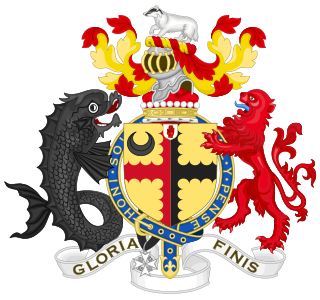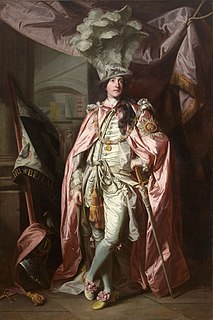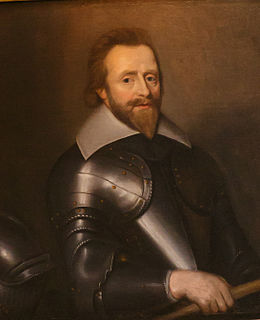Related Research Articles

Earl of Kingston is a title in the Peerage of Ireland. It was created in 1768 for Edward King, 1st Viscount Kingston. The Earl holds the subsidiary titles Baron Kingston, of Rockingham in the County of Roscommon, Viscount Kingston, of Kingsborough in the County of Sligo, Baron Erris, of Boyle in the County of Roscommon, and Viscount Lorton, of Boyle in the County of Roscommon, also in the Peerage of Ireland. He is also a baronet in the Baronetage of Ireland. Between 1821 and 1869 the earls also held the title Baron Kingston, of Mitchelstown in the County of Cork, in the Peerage of the United Kingdom.

Viscount Brookeborough, of Colebrooke in the County of Fermanagh, is a title in the Peerage of the United Kingdom. It was created in 1952 for the Ulster Unionist politician and Prime Minister of Northern Ireland, Captain The Rt. Hon. Sir Basil Brooke, 5th Bt., P.C. (N.I.), M.P.

Viscount Grandison, of Limerick, is a title in the Peerage of Ireland. It was created in 1620 for Sir Oliver St John, the Lord Deputy of Ireland. He was the descendant and namesake of Oliver St John, whose elder brother Sir John St John was the ancestor of the Barons St John of Bletso and the Earls of Bolingbroke. Moreover, St John's nephew Sir John St John, 1st Baronet, of Lydiard Tregoze, was the ancestor of the Viscounts Bolingbroke and the Viscounts St John.

William de Berkeley, 1st Marquess of Berkeley was an English peer, given the epithet "The Waste-All" by the family biographer and steward John Smyth of Nibley. He was buried at "St. Augustine's Friars, London" according to one source, but most likely in the Berkeley family foundation of St Augustine's Abbey, Bristol.

Earl of Hyndford was a title in the Peerage of Scotland. It was created in 1701 for John Carmichael, 2nd Lord Carmichael, Secretary of State from 1696 to 1707. He was made Lord Carmichael and Viscount of Inglisberry and Nemphlar at the same time, also in the Peerage of Scotland. He was the grandson of James Carmichael, who had been created a Baronet, of Westraw in the County of Lanark, in the Baronetage of Nova Scotia in 1627, and raised to the Peerage of Scotland as Lord Carmichael in 1647. The third Earl was a prominent diplomat. The titles became dormant on the death of the sixth Earl in 1817, and were later unsuccessfully claimed by James Carmichael Smyth and his great-grandson James Morse Carmichael.

Earl of Bellomont, in the Kingdom of Ireland, was a title that was created three times in the Peerage of Ireland. The first creation came on 9 December 1680 when Charles Kirkhoven, 1st Baron Wotton, was made Earl of Bellomont. He had already been created Baron Wotton, of Wotton in the County of Kent, in the Peerage of England on 31 August 1650. He was childless and both titles became extinct on his death in 1683.
William Power Keating Trench, 1st Earl of Clancarty was an Irish aristocrat and politician and later United Kingdom statesman at the time of the Act of Union. His family, through his son Richard, became prominent and hereditary members of the Netherlands' nobility.

Baron Mansel, of Margam in the County of Glamorgan, was a title in the Peerage of Great Britain. It was created on 1 January 1712 for Sir Thomas Mansel, 5th Baronet, previously Member of Parliament for Cardiff and Glamorganshire. His ancestor had been created a Baronet, of Margam in the County of Glamorgan, in the Baronetage of England on 22 May 1611. The fourth Baronet represented Glamorgan in the House of Commons. The fourth Baron sat as Member of Parliament for Cardiff. On his death 29 November 1750 the barony and baronetcy became extinct.
Baron Castle Coote, in the County of Roscommon, was a title in the Peerage of Ireland. It was created in 1800 for Charles Coote, 7th Earl of Mountrath, with remainder to his kinsman Charles Coote. The earldom of Mountrath became extinct on his death in 1802 while he was succeeded in the barony according to the special remainder by the aforementioned Charles Coote, the second Baron, who had previously represented Queen's County and Maryborough in the Irish House of Commons. The second Baron was the son of the Very Reverend Charles Coote, Dean of Kilfenora, great-grandson of Chidley Coote, younger son of Sir Charles Coote, 1st Baronet and brother of Charles Coote, 1st Earl of Mountrath. He was succeeded by his only surviving son, Eyre, the third Baron, who died childless in 1827, when the barony became extinct.
There have been three baronetcies created for members of the Shelley family, one in the Baronetage of England and two in the Baronetage of the United Kingdom. The three recipients of the titles represented two different branches of the family with a common ancestor in John Shelley of Michelgrove. The most famous member of the family is the poet Percy Bysshe Shelley, although he never held any title. The holders of the third and last creation were later elevated to the peerage as Baron De L'Isle and Dudley and Viscount De L'Isle.
Charles Rupert Bard, 2nd Viscount Bellomont (1647–1667) was the only son of Sir Henry Bard. He was killed in action whilst serving in the Barbados Regiment, during the battle to recapture St Kitts from the French in 1667.
John Browne, 1st Baron Kilmaine, known as Sir John Browne, 7th Baronet, from 1765 to 1789, was an Irish politician.
There have been three baronetcies created for members of the Gore family, all in the Baronetage of Ireland. All three titles are extant. The family also holds two earldoms and a barony.
Arthur Gore, 1st Earl of Arran PC (Ire), known as Sir Arthur Gore, 3rd Baronet from 1741 to 1757 and as Viscount Sudley from 1758 to 1762, was an Irish politician.
There have been six baronetcies created for persons with the surname Brooke, one in the Baronetage of England, one in the Baronetage of Ireland and four in the Baronetage of the United Kingdom. As of 2015 four of the creations are extant, though one has been subsumed into a peerage.
The Chance Baronetcy, of Grand Avenue in the parish of Hove in the County of Sussex, is a title in the Baronetage of the United Kingdom. It was created on 19 June 1900 for James Timmins Chance, a grandson of William Chance one of the Chance brothers who started the family business in 1771. He became head of Chance Brothers and Company. He was High Sheriff of Staffordshire in 1868.

There have been three baronetcies created for persons with the surname Ball, one in the Baronetage of England and two in the Baronetage of the United Kingdom.

There have been two baronetcies created for members of the Coote family. The first is Coote of Castle Cuffe, while the second is Coote of Donnybrooke, both in the Baronetage of Ireland. As of 2020, the first creation is still extant. The holders of the first creation also held the title of Earl of Mountrath between 1660 and 1802.
The Johnson-Walsh Baronetcy, of Ballykilcavan, was a title in the Baronetage of Ireland. It was created on 24 February 1775 for John Allen Johnson, who changed his name by royal licence in 1809 to John Allen Johnson-Walsh. He was the elder brother of Sir Henry Johnson, 1st Baronet, of Bath. He was M.P. for Baltinglass from 1784 to 1790, and High Sheriff of Queen's County for 1792.

John Charles Ramsden was a British Whig politician from Newby Park in Yorkshire. He sat in the House of Commons between 1812 and 1836.
References
- Leigh Rayment's Peerage Pages [ self-published source ][ better source needed ]
- Lundy, Darryl. "p. 883 § 8827 - Sir Henry Bard, 1st Viscount Bellomont". The Peerage.[ unreliable source ]
- Lundy, Darryl. "p. 12952 § 129517 - Sir Charles Rupert Bard, 2nd Viscount Bellomont". The Peerage.[ unreliable source ]